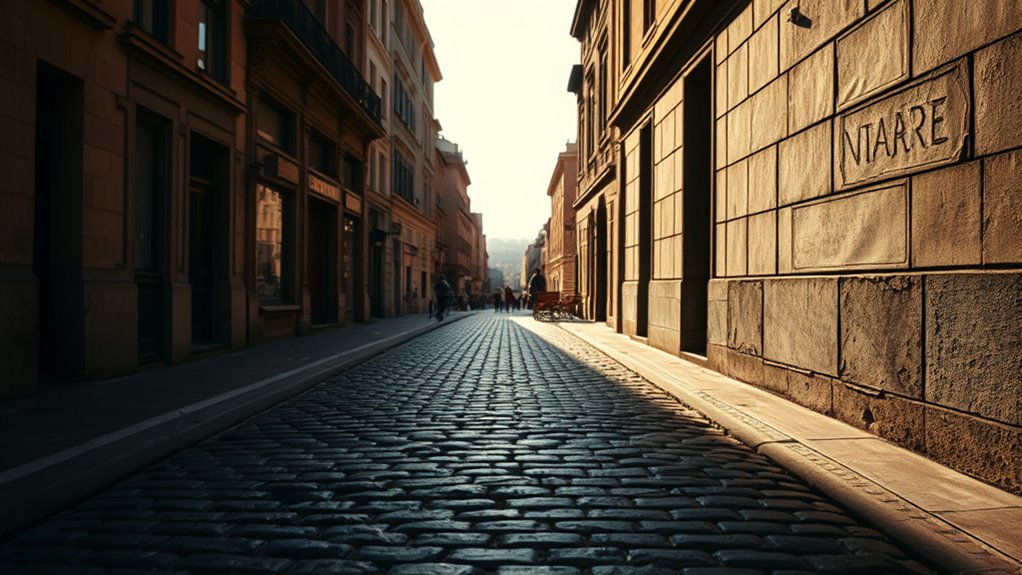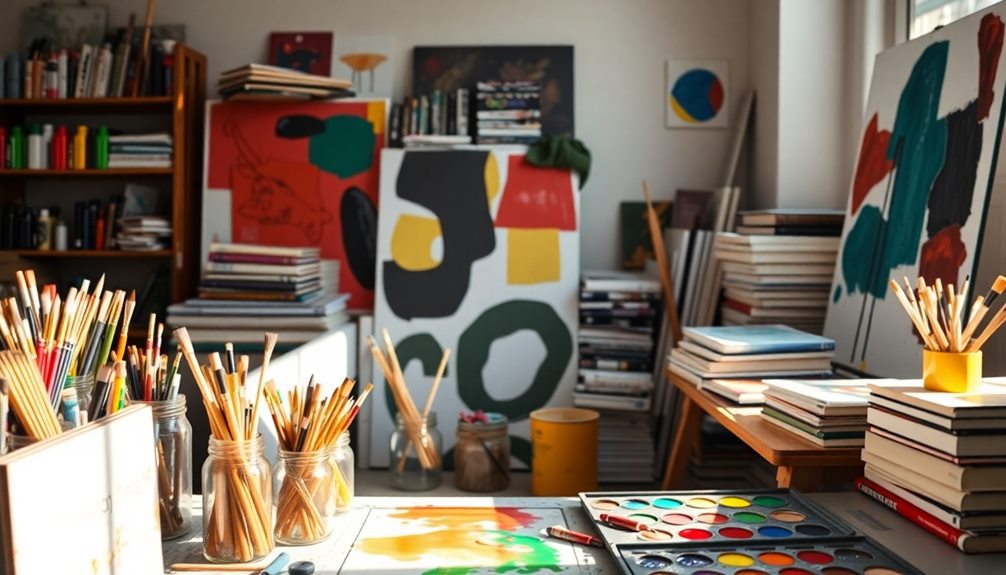To create the illusion of depth in art, you use techniques like perspective, foreshortening, and atmospheric effects to manipulate visual cues. Perspective tricks the eye into perceiving a flat surface as three-dimensional by using accurate lines, vanishing points, and converging angles. Foreshortening emphasizes parts of objects closer to the viewer by enlarging them, while atmospheric perspective softens distant objects with lighter, hazier, and less detailed features. Keep exploring these methods to master convincing realism in your artwork.
Key Takeaways
- Artists use perspective techniques like foreshortening to depict objects at angles, creating depth on a flat surface.
- Atmospheric perspective lightens and softens distant objects, enhancing the illusion of depth.
- Enlarging foreground elements and reducing size for background objects establish spatial recession.
- Combining foreshortening and atmospheric effects adds realism and layers to compositions.
- Observing real objects improves understanding of light, space, and proportion, strengthening depth illusion skills.

Have you ever wondered how artists create a sense of depth and realism in their work? It all comes down to mastering perspective, which involves clever techniques to trick your eye into perceiving three-dimensional space on a flat surface. One of the key methods artists use is foreshortening, a technique that involves depicting objects or figures at an angle so that parts closer to you appear larger, while those farther away seem smaller. This effect gives the illusion that the object extends into space, creating a dynamic sense of depth. For example, if you’re painting a figure reaching toward you, the hand closest to the viewer will be enlarged compared to the rest of the body, emphasizing the sense of spatial recession. Foreshortening requires precise observation and skill because it challenges your sense of proportion, making the figure appear convincingly three-dimensional. Developing an understanding of visual perception allows artists to manipulate these techniques more effectively, enhancing the realism of their work. Recognizing how our perception of depth influences visual interpretation can help artists craft more convincing compositions.
Alongside foreshortening, atmospheric perspective plays a crucial role in establishing depth, especially in landscape art. When you look at distant mountains or trees, they often appear hazy, lighter in color, and less detailed compared to objects in the foreground. Artists replicate this effect by gradually reducing contrast, softening edges, and lightening colors as elements recede into the background. This mimics how the atmosphere filters light and scatters particles, causing distant objects to seem more muted and less distinct. By carefully applying atmospheric perspective, you can create a convincing illusion of vast space, guiding the viewer’s eye from the foreground to the distant horizon. Both foreshortening and atmospheric perspective work together to build a layered, immersive scene on a two-dimensional surface. Additionally, understanding scientific principles of light and color can further improve the accuracy of atmospheric effects in art. Recognizing how our perception of depth cues influences visual interpretation can help artists craft more compelling compositions.
Understanding how to combine these techniques allows you to depict scenes with remarkable realism and depth. Foreshortening adds immediacy and tension, drawing the viewer into the scene through dramatic perspectives. Meanwhile, atmospheric perspective provides a sense of scale and distance, helping your artwork feel expansive and believable. Whether you’re painting a portrait, a still life, or a sprawling landscape, mastering these methods will elevate your work by adding depth that feels natural and engaging. As you experiment, remember that observing real-world objects and scenes closely will improve your ability to apply foreshortening and atmospheric effects effectively. With practice, you’ll develop a keen eye for how light, space, and proportion interact, transforming your flat canvas into a convincing illusion of three-dimensional reality.
Frequently Asked Questions
How Do Artists Choose Which Perspective Techniques to Use?
When choosing perspective techniques, you consider your focal points and vanishing points to guide the viewer’s eye. Think about the scene’s depth and how you want to lead attention to specific areas. You might select one-point, two-point, or three-point perspective based on the composition’s complexity and the mood you aim to create. Your choice shapes how viewers perceive space, making your artwork more engaging and realistic.
Can Perspective Be Used to Manipulate Viewer Emotions?
You can definitely use perspective to manipulate viewer emotions. By shifting the viewer’s focus or creating a sense of chaos or calm, perspective techniques influence emotional impact and enhance viewer engagement. For example, exaggerated perspective can evoke tension, while a gentle, balanced perspective can foster serenity. Artists intentionally choose these methods to guide how viewers feel, making their artwork more powerful and compelling through strategic use of perspective.
How Does Digital Art Incorporate Perspective Differently?
In digital art, you leverage virtual depth to create immersive scenes, making viewers feel part of the environment. You also use color perspective, where warmer colors seem closer and cooler ones recede, enhancing the illusion of space. Unlike traditional methods, digital tools allow you to manipulate these elements precisely, blending real and virtual depth seamlessly. This dynamic approach helps you craft more engaging, three-dimensional experiences for your audience.
Are There Cultural Differences in Perspective Methods?
Imagine you’re studying traditional Chinese scroll paintings, where cultural symbolism and artistic traditions influence perspective methods. You notice they often use flattened, layered images instead of linear depth, reflecting different cultural views on space. Cultural differences shape how artists create depth, emphasizing spiritual or symbolic meanings over realistic depth. So, yes, perspectives vary worldwide, shaped by cultural symbolism and artistic traditions that influence how artists depict space and depth.
What Are Common Mistakes Beginners Make With Perspective?
When you start working with depth perception, beginners often struggle with foreshortening techniques, making objects appear unnatural or distorted. You might also forget to apply consistent vanishing points, which disrupts the sense of depth. To improve, focus on understanding how perspective lines guide your composition and practice applying foreshortening accurately. Avoid rushing these steps, as mastering them helps create a convincing illusion of three-dimensional space.
Conclusion
As you master perspective, you step into the shoes of the great masters who painted worlds beyond sight, creating illusions that invite viewers to wander within your art. Remember, like a modern-day Magritte, you craft a reality that challenges perception, blending depth and dimension seamlessly. Your work becomes a portal, echoing the timeless dance between illusion and truth—reminding us all that, with skill, the boundaries of perception are only as real as you make them.









